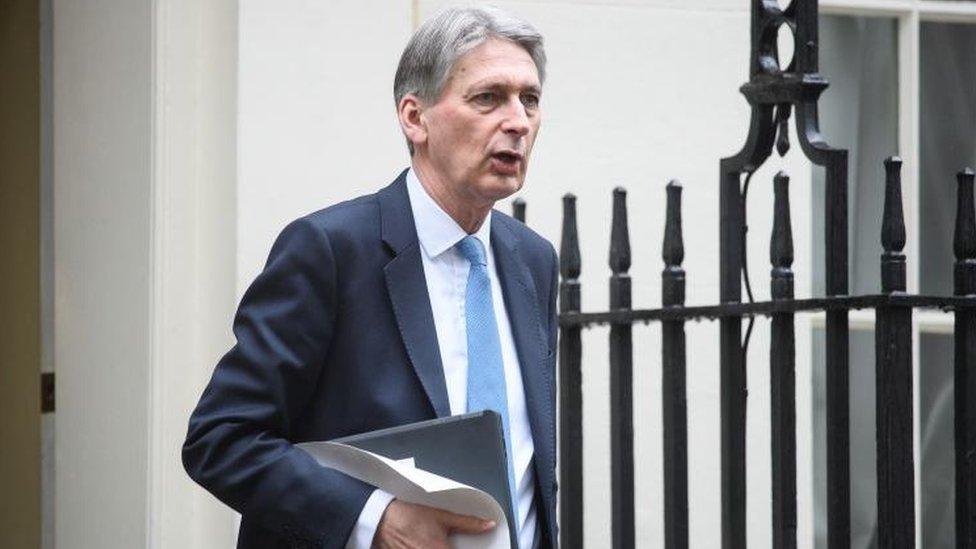Public finances and the shadow of Osborne
- Published
- comments
Philip Hammond knows all about the government's attempts to "get the public finances in order" following the financial crisis of 2008.
He was the man, as shadow Chief Secretary to the Treasury, credited by many for the tough detail of the austerity plan laid before voters in the run up to the 2010 election.
George Osborne was the architect, Mr Hammond the foreman, ensuring there was a plan that might actually have a chance of working, public sector cut by public sector cut.
Now Mr Hammond is the man in charge of the public finances - his dream government job and, a relatively rare occurrence for the resident of Number 11, said authoritatively to be the high water mark of his ambitions.
Whatever his relations with the Prime Minister, and they are better than often reported, the fact that he doesn't want to move his sofas next door is a useful salve to any scratchiness between Downing Street's most important neighbours.

Mr Hammond expected to take a "steady-as-she-goes" approach to his first Budget
Today sees the publication of the Institute for Fiscal Studies' (IFS) annual Green Budget, its analysis of Mr Hammond's room for manoeuvre as he prepares for the real Budget, on 8 March.
There is one clear message.
If you thought the era of cuts is over, think again.
Day-to-day spending, officially known rather more prosaically as the Resource Departmental Expenditure Limit (which excludes investment spending), is set to fall by 4% over the next three years.
The IFS says that a "particularly sharp cut" has been loaded onto the last year of the parliament, 2019-20, never a particularly comfortable time for a government to be squeezing the public sector pips even more aggressively.
Alongside that, the IFS says the overall tax burden is set to rise as a proportion of national income to the highest level since 1986.
That is not a function of actual tax rises - taxes for many millions of people have fallen as income tax thresholds have risen - but a function of a relatively high tax take throughout an era of pretty stagnant growth.
Will Mr Hammond change course on 8 March, and further loosen the government's austerity strictures as he did in the Autumn Statement last year - pushing the deficit reduction target into the conveniently indistinct long grass of "during the next parliament"?
The government has, after all, promised an economy that works for all.
I am told not - and that Mr Hammond is approaching his first Budget as a "steady-as-she-goes affair" with no major yanks on the national rudder, particularly given the economy's robust performance since the Brexit referendum.

Servicing the UK's debt costs about £34bn a year
It has been pointed out to me that, just ahead of the triggering of Article 50 - the official mechanism for leaving the European Union - the last thing Britain needs is a reset of fiscal policy.
In 2010, the Conservatives were elected as the party that would bring public income and public expenditure into balance.
Mr Hammond still cleaves to that view. "He is a Conservative," as one official close to him says.
George Osborne's economic approach is alive and well.
Yes, there are criticisms by some economists that there is no need to run a country like a household budget where pennies in and pennies out matter - governments are able to borrow at very cheap rates on the international markets and put that money to economically valuable use.
Yes, there are criticisms that debt costs as a percentage of national income are low by historic standards and so the room for manoeuvre is rather greater than the national debt headline figures suggest.
But those close to Mr Hammond argue that, OK, borrowing may be cheap now but servicing Britain's £1.7 trillion debt is still expensive, costing around £34bn a year, or 4.6% of all government spending.
Cut out the deficit and start dealing with the debt and those costs can be brought down.
Certainly, since the referendum, the cost of government debt has increased as rising inflation risk pushes up yields - the interest rate on government bonds issued to investors.
Gig economy
Mr Hammond is briefing the Cabinet for the first time this week on the broad parameters of next month's Budget.
He will talk about Britain's historic productivity problem and how to solve it, he will talk about skills, he will talk about research and development support and he will talk about infrastructure spending.
Supporting the private economy is his priority, not reversing public sector cuts.
Mr Hammond will also say that the new world of work - the gig economy - is affecting the way the Treasury has to approach complicated issues such as tax receipts as the number of self-employed - who tend to pay a lower proportion of their income to the state - grows.
A lot of it will be rhetoric at this stage.
For Mr Hammond wants to keep his powder dry.
Dry for the bigger fiscal event of the year, the autumn Budget (as we should now call it) in November or December.
As he said last year, he only wants one major tax and spend "moment" a year.
And it's not going to be next month.